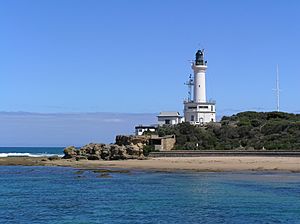Point Lonsdale Lighthouse facts for kids
| Location | Entrance to Port Phillip Bay Victoria Australia |
|---|---|
| Coordinates | 38°17′31″S 144°36′50″E / 38.29194°S 144.61389°E |
| Year first lit | 20 March 1902 |
| Automated | 1999 |
| Construction | concrete tower on octagonal prism signal station and observation room |
| Tower shape | cylindrical tower with balcony and lantern |
| Markings / pattern | white tower and black lantern and dome |
| Height | 21.3 metres (70 ft) |
| Focal height | 36.6 metres (120 ft) |
| Range | 22 kilometres (14 mi) (white light) 19 kilometres (12 mi) (red light) |
| Characteristic | Fl (2) W 15s. (horizontal beam) |
| Fog signal | diaphone: 2 blast every 30 seconds |
The Point Lonsdale Lighthouse is also called the Point Lonsdale Signal Station. It is located near the town of Point Lonsdale in Victoria, Australia. This lighthouse stands on the eastern side of the Bellarine Peninsula. It helps guide ships into Port Phillip from Bass Strait.
The lighthouse overlooks an area called The Rip. This part of the water is known for being tricky for ships. It is the only way for ships to reach Melbourne by sea. The Victorian Ports Corporation (Melbourne) manages the lighthouse.
Contents
About the Lighthouse
The lighthouse you see today was finished in 1902. It was designed by the Victorian Public Works Department. The Coate Brothers built it. It looks like many other lighthouses from the late 1800s. For example, it is similar to the Point Hicks Lighthouse.
This lighthouse is special because it was one of the first to use reinforced concrete. At the top, it has a lantern made by Chance Brothers. The original lamp used oil. Later, it was changed to an acetylene light. Now, it uses an electric light.
Around the bottom of the tower is a two-story brick building. This building is the signal station and observation room. Halfway up the tower, there is a platform. This platform holds red and green navigation lights. These lights help guide ships safely.
History of the Lighthouse
The first navigation aid at Point Lonsdale was a signal station. It was built in 1852. In 1856, a red pillar beacon was added. In 1863, an older wooden lighthouse was moved here. It was painted with black and red stripes. This wooden lighthouse used a temporary light at first. A permanent light was lit in 1867.
The wooden lighthouse was replaced by the concrete tower in 1902. The old wooden tower was taken apart in 1912. Its wood was used for firewood.
In 1915, the state of Victoria handed control of the light to the Commonwealth government. It was given back to Victoria in 1934. The lighthouse was then called a "Harbour Entrance Light." The signal station and observation room were added to the base of the tower in 1950.
The light itself became automatic in 1999. However, people still work at the signal station. They control the movement of large ships. This makes it possibly the last staffed lighthouse in Australia.
Why the Lighthouse is Important
The Point Lonsdale Lighthouse area is very important. It includes the lighthouse and other buildings. These buildings helped with lighthouse operations and navigation. There are also military defence structures nearby. These were built during the First and Second World Wars.
The whole area is important for its design, past, and old remains. It is listed by Heritage Victoria. This shows its value to the state of Victoria.
The lighthouse is historically important because of its connection to shipping and defence. The lighthouse structures show how important navigation aids were. Shipping was vital for trade between Port Phillip and the rest of the world. This lighthouse was the first guiding light for ships entering Port Phillip from the sea. The defence structures show how important it was to protect Port Phillip. This included the major cities of Melbourne and Geelong during both World Wars.
The buildings in the lighthouse area are also important for their design. This includes a foghorn shed built in 1884. There is also an explosives shed from 1891. The lighthouse itself is a beautiful example of an early 20th-century lighthouse. The foghorn shed is the only one known from a Victorian lighthouse. It has an old Gardner Engine that powers the foghorn. This is very rare to see in its original place. The area is also important for archaeology. It might have old items that show how the site was used as a light station and signal station.
The Lighthouse Today
The outside of the lighthouse was repaired in 1997. In 2002, Heritage Victoria and the Victorian Channels Authority worked together. They restored the inside of the lighthouse. Celebrations for the lighthouse's 100th birthday were held on March 23, 2002.
The restored foghorn is used when it is foggy. It makes two loud blasts every 30 seconds. You can visit the area around the tower. The Queenscliffe Maritime Museum offers tours on Sundays. The ocean waters around the lighthouse are protected. They are part of the Port Phillip Heads Marine National Park.
See also


